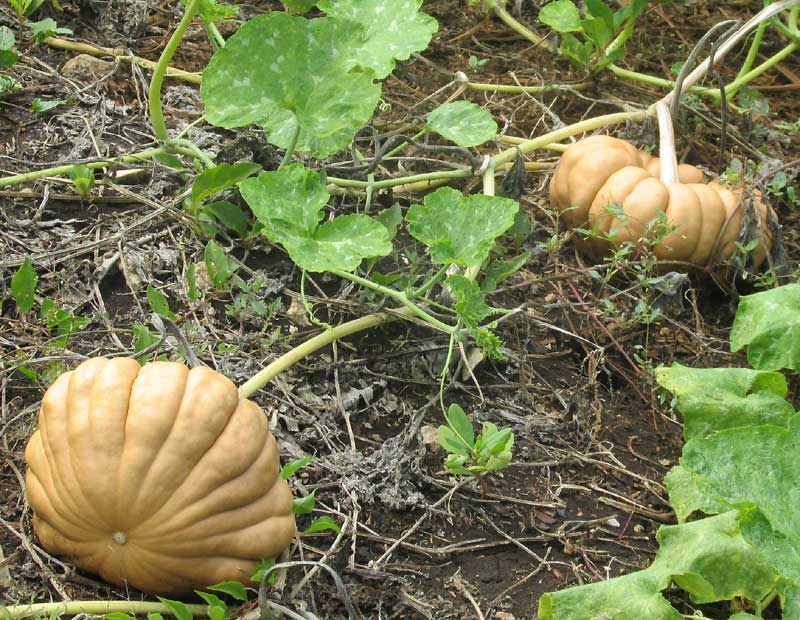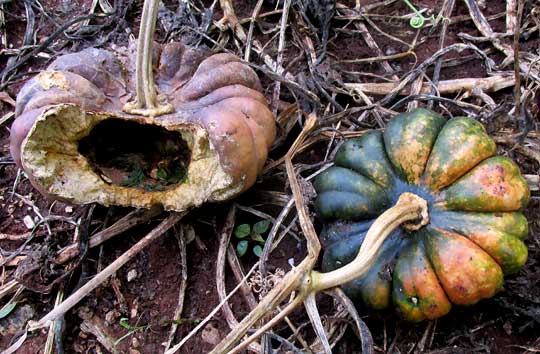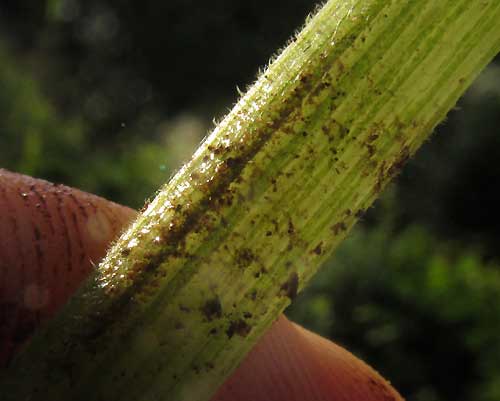Excerpts from Jim Conrad's
Naturalist Newsletter
from the November 1, 2015 Newsletter issued from Hacienda Chichen Resort beside Chichén Itzá Ruins, central Yucatán, MÉXICO
NOHOCH CUM/ MAYA RIBBED SQUASH

In the Cucumber Family, pumpkins, gourds, squash, melons and cucumbers aren't always clearly identifiable as belonging to one or the other of those groupings. You might remember our "Maya Cucumbers" that turned out to be cucumber-like melons, the story told at www.backyardnature.net/yucatan/pepino.htm.
In the Hacienda's garden, nowadays ground-running vines are producing a big crop of tough-skinned, conspicuously ridged, pumpkin/squash-like fruits, shown above. Notice that these vines' leaves are roundish in shape and not deeply lobed, setting them apart from many other Cucumber Family vine types. Also, the fruits are fairly large, as shown below with my hand for scale:

The fruits lobes provide most of the edible "flesh," as is apparent below on a fruit partly eaten by, probably, an Agouti:

That picture also shows that before these fruits mature they are dark green.
Cucumbers and melons belong to the genus Cucumis, whose flowers consist of five distinct petals or nearly separate corolla lobes. Pumpkins, gourds and squash are in the genus Cucurbita, which produces bell-shaped corollas with only shallowly defined corolla lobes. Our vines produce bell-shaped corollas so we can confidently say that our vines' fruits are of the pumpkin/gourd/squash type, in the genus Cucurbita. Our vine's typically Cucurbita, shallowly lobed corolla is shown below:

So, what kind of pumpkin/gourd/squash of the genus Cucurbita is this?
Within the genus Cucurbita, all our multivarious garden pumpkins, gourds and squash are derived from about five domesticated species, which occasionally cross pollinate, confusing the picture. In figuring out which species of Cucurbita our Hacienda vines belong to, the following features were noted:
 <
<
These features direct us to CUCURBITA MAXIMA, home to many varieties of what Northerners call Autumn and Winter Squashes, such as the Hubbard, buttercup, Boston Marrow and Amish Pie Pumpkin squashes. In other words, despite our fruits being the size and hardness of a pumpkin, they're better thought of as squashes.
Cucurbita maxima is regarded as one of the most diverse domesticated Cucurbita species. Over 4000 years ago it was brought into cultivation in South America, probably being derived from the wild Cucurbita andreana. It's known that domesticated Cucurbita maxima was introduced into North America as early as the early 1500s, while archaeological evidence shows that squashes were cultivated in Mexico before the Spanish Conquest.
On the Internet, since I can't find illustrations of Cucurbita maxima squash exactly like ours, I'm guessing that once again here we have a unique variety produced by the Maya through centuries of selective breeding. Our hot, dry environment certainly is different from that of the Andes, so we have to admire the fruit of the work of our indigenous plant breeders.
The name "Maya Ribbed Squash" is one I made up because our squash doesn't seem to have an English name. The local Maya call it Nohoch Cum -- Cum meaning squash, and Nohoch "very big" -- and they tell me the way you prepare it is in a "pib," a hole in the ground with rocks heated to a high temperature by burning wood around them. Put Nohoch Cum into the pit with hot stones, usually when something like a pig is the main item being cooked, cover the pib, and let everything slow-cook until well done.
Then Nohoch Cum is sweet like sweet potato. Once it's cooked soft, add sugar until you have something like candied yam. Around here it's the common squash grown in traditional cornfields, or milpas.